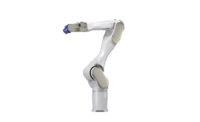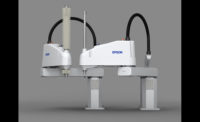As multiaxis robots add more peripherals and advanced features, it can be easy to overlook the unsung devices in the workcell and they role they play in maximizing uptime. One example is the robotic dress pack. Since cable issues are often a significant cause of downtime for robots, it’s important to select dress packs that can address common cable management challenges while optimizing efficiency and throughput.
When selecting a dress pack, it’s important to consider devices with the right combination of features, such as torsion and flexing resilience, ease of installation and maintenance, and integrated sensor options. Taken together, these characteristics can increase system availability and productivity for six-axis robots while reducing maintenance and repair needs.
Let’s explore some of the variables to consider when choosing a cable management system, along with the ways 3D, modular dress packs check these boxes.
Take Mechanical Stresses Into Account
In robotic workcells, wires and cables are prone to damage, making it important to consider their operating conditions when managing a system. For example, six-axis rotating systems with a large range of motion must continuously bend and flex for millions of cycles. This means the cable management systems must also account for extreme torsional movement that can strain cables and cause wear and tear.
Tangled cables are another source of wear and tear. The time and effort to replace, repair or untangle cables is expensive and will hold up production.
Cable management in six-axis systems vary in effectiveness. There are makeshift methods like duct tape and bungee cords, as well as corrugated products that offer more strength, but limited flexibility. Another option is the enclosed dress pack. Its sturdy structure typically offers the most protection against wire and cable damage.
While enclosed dress packs provide peace of mind against harm, not all of them are created equal. For example, newer dress packs that have a 3D design and construction elements will surpass the elementary protection features of conventional cable management systems.
Here’s a rundown of the challenges an advanced 3D robotic dress pack can solve:
Continuous flexing and torsion. Continuous or complicated motion over millions of cycles puts tremendous stress on cables. Unlike conventional cable management systems, which lack the flexibility to withstand mechanical stress, 3D dress packs offer torsion and flexing resilience, reducing the strain imposed on the cables.
One such dress pack, the triflex R cable carrier from igus, has a ball and socket link design to provide high tensile strength and an ability to adjust to changes in the robot’s motion. It also features built-in torsion stops that reduce mechanical stress by evenly distributing the torsion across the entire length of the chain. When choosing the dress pack, it’s important to select a unit with a bend radius that corresponds to the maximum bend radii of your cables.
Tangling and abrasion. Tangling often occurs when various types of cables are bundled together, but not adequately separated. Dress packs with multiple cavities can prevent high-density cable arrangements that can otherwise tangle cables.
Assembly and installation. In robotic applications, the easier it is to install and remove your cable management system, the faster you can get your robot back up and running. You can mount enclosed dress packs directly to the robot, eliminating the need for time-consuming cable lashing.
More advanced dress packs also feature a modular design that allows you to achieve your desired length and cable arrangement simply by adding or removing individual links. This modularity slashes the time needed to install or remove cables.
Maintenance and repairs. When it’s time to perform maintenance or add or remove cables, conventional dress packs require personnel to disassemble the entire system. Modular ball-and-socket-style 3D dress packs allow easier access. Should a breakage occur, you can also easily replace the individual pieces of the system with significantly less downtime.
Unplanned repairs. One innovative cable management system comes with integrated sensors that monitor the conditions that can cause unplanned downtime. For example, energy chain systems are susceptible to extreme loading that can break individual chains. These integrated sensors connect directly to the PLC, sending signals that allow personnel to respond to and rectify the situation before a breakdown occurs.
More Tips for Reliable Performance
When selecting your dress pack, look for a product that comes in many sizes and retraction systems, enabling you to work with your preferred robot in a wide range of applications. You can also prevent damage by selecting dress packs with a defined bend radius that doesn’t exceed your cables’ rated maximum bending radii. A cable management provider can help you configure an optimal system with the required cables and connectors upon delivery.
To further ensure a long lifetime and reduce downtime for your robotic cable systems, consider these additional tips:
- Look for dress packs made from durable materials that have been tested for reliability under harsh conditions.
- Ensure proper clearances between hoses and cables.
- Consider cable management early in the design process so you can anticipate previously unforeseen requirements.





